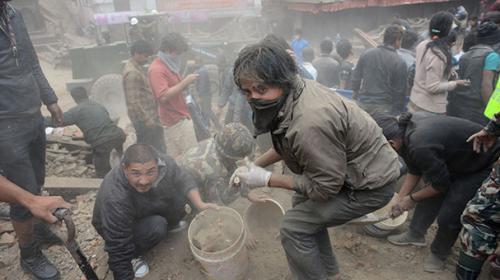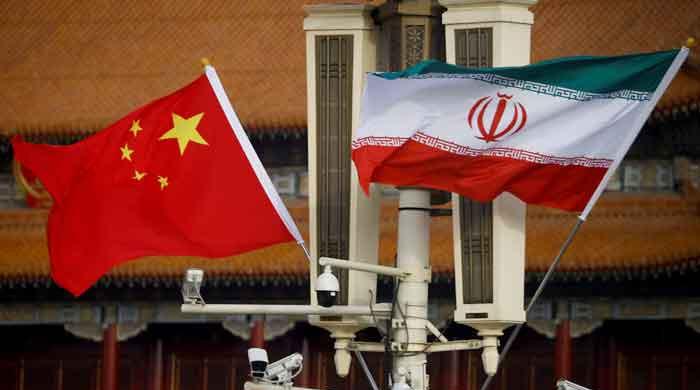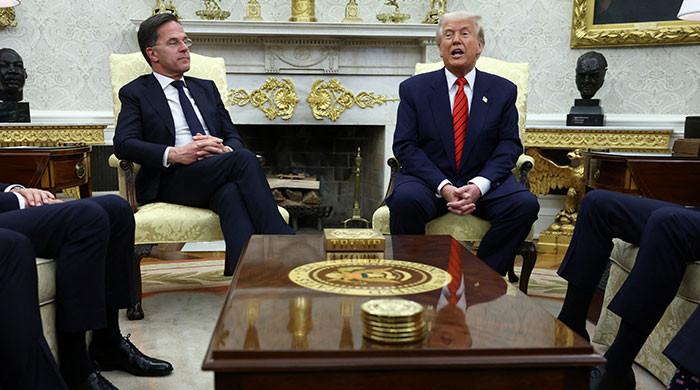Aftershocks jolt Nepal as death toll from quake tops 2,000
KATHMANDU: Rescuers in Nepal searched frantically Sunday for survivors of a huge quake that killed more than 2,000, digging through rubble in the devastated capital Kathmandu and airlifting victims...
April 26, 2015

Terrified residents of Kathmandu were woken by fresh aftershocks in the worst disaster to hit the impoverished Himalayan nation in more than 80 years, with many forced to spend the night trying to sleep out on the streets and open ground in makeshift tents.
Hospitals were so stretched that medics had set up tents outside the buildings to treat patients.
The historic nine-storey Dharahara tower, a major tourist attraction, was among the buildings brought down, with at least a dozen bodies taken away from the ruins of the 19th-century tower.
“The toll has reached 1899, more than 4,500 are injured,” national police spokesman Kamal Singh Bam told AFP.
“We have deployed all our resources for search and rescues. Helicopters have been sent to remote areas. We are sifting through the rubble where buildings have collapsed to see if we can find anyone."
Officials said that 17 people were so far known to have died on Mount Everest where an avalanche triggered by the earthquake buried part of base camp.
It is the deadliest disaster in Everest´s history and comes almost exactly a year after an avalanche killed 16 sherpa guides.
News agency AFP’s Nepal bureau chief Ammu Kannampilly, on an assignment at base camp, reported that six helicopters had managed to reach the mountain on Sunday morning after the weather had improved overnight.
Also read: Pakistani aircraft reach quake-hit Nepal to aid in relief efforts
“People being stretchered out as choppers land – half a dozen this morning,” Kannampilly said in a text message.
“Weather clear, some snowfall.”
The overall toll was expected to be much higher, and at least 47 people have died in neighbouring India.
“We are using all our resources for rescue and to help the displaced,” Rameshwor Dangal, who heads Nepal´s Himalayan nation´s National Disaster Management Division, told AFP.
Chinese state media said 17 people had also been killed in Tibet as Beijing sent a team of 62 rescuers, accompanied by sniffer dogs, to help the hard-pressed emergency workers in Nepal.
The county’s cell phone network was working only sporadically, while large parts of the capital were without electricity.
New aftershocks
The USGS said another strong 6.7-magnitude aftershock struck Nepal on Sunday with climbers reporting the tremor triggered more avalanches on Mount Everest.
The latest quake struck northeast of Kathmandu near the border with China at a depth of 10 kilometres (6.2 miles), the US Geological Survey said.
Climber Jim Davidson said he felt the aftershock at Camp One on Everest.
“Just had our biggest aftershock yet here at C1 on Everest. Smaller than original quake but glacier shook & avalanches,” he tweeted.
AFP correspondents in Kathmandu reported that tremors were felt throughout the night, including one strong aftershock at dawn.
“It has been a sleepless night, how can we sleep? It has been shaking all night. We are just praying that this will end and we can return home,” said Nina Shrestha, a 34-year-old banker who spent the night with hundreds of people on open ground in the capital´s Tudhikhel district.
As rescuers sifted through the huge mounds of rubble, the hospitals were overflowing with victims who suffered multiple fractures and trauma.
“We have treated many people since yesterday, majority children,” said Samir, a doctor at Nepal’s Annapurna Neurological Hospital.
“Most patients have head injuries or fractures. Two of our patients died, two are critical.”
Acharya said that medics were working out of a tent set up in a parking lot because of overflowing patients, while some patients were too scared to stay in the building.
Families had grabbed whatever possessions they could muster and sought shelter on the streets, many of which had been split asunder.
Weather forecasters warned that rain was on the way, with dark clouds looming over Kathmandu that promised more misery for displaced survivors.
’Huge’ Everest disaster
Snowfalls on Saturday had thwarted efforts to airlift survivors from Everest base camp, where hundreds of mountaineers were gathered at the start of the annual climbing season, cancelled last year after the deaths of the 16 sherpa guides.
Google executive Dan Fredinburg was the only climber killed to have been identified so far.
Experienced mountaineers said panic erupted at base camp, which has been “severely damaged”, while one described the avalanche as “huge”.
“Seventeen have been reported dead so far and 61 are injured,” said Tulsi Gautam of Nepal’s tourism department which issues permits to climb the world´s tallest mountain.
“Those who are able are walking down. Others are being airlifted.”
Kannampilly, who was injured in Saturday´s disaster, said many of those stranded at the scene were walking down the mountain rather than risk being stuck for days.
George Foulsham, a Singapore-based marine biologist, described the moment that the disaster struck.
“I was outside, saw a white 50-storey building of white come at me. I ran and it just flattened me,” he told AFP.
“I tried to get up and it flattened me again. I couldn’t breathe, I thought I was dead. When I finally stood up, I couldn´t believe it passed me over and I was almost untouched.
“I saved for years to climb Everest. It feels like the mountain is saying it´s not meant to be climbed for now. Too much of a coincidence to see this twice in two years.”
Offers of support
Offers of help poured in from governments around the world, with two Pakistani aircraft with relief goods and rescue team arriving on Sunday.
The United States and European Union have also announced that they are sending in disaster response teams. India flew out its stranded citizens in military planes.
Nepal and the rest of the Himalayas are particularly prone to earthquakes because of the collision of the Indian and Eurasia plates.
A 6.8-magnitude quake hit eastern Nepal in August 1988 killing 721 people, and a magnitude 8.1 quake killed 10,700 people in Nepal and eastern India in 1934.
The Red Cross (IFRC) said meanwhile it was concerned about the fate of rural villages close to the epicentre of the quake northwest of the capital Kathmandu.
"Roads have been damaged or blocked by landslides and communication lines are down preventing us from reaching local Red Cross branches to get accurate information," said IFRC Asia Pacific director Jagan Chapagain.
International aid groups and governments have sent emergency crews to reinforce those scrambling to find survivors in the devastated capital, Kathmandu, and in rural areas cut off by blocked roads and patchy phone networks.











